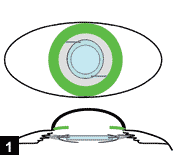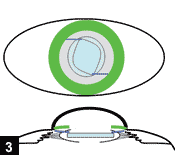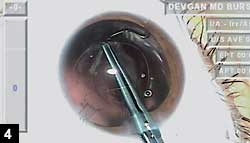Cataract surgery more challenging with an open posterior capsule
There are several alternatives for IOL insertion that result in optic capture and long-term stability.

For the majority of cataract surgeries, the posterior capsule is intact, and we can easily implant a variety of IOL implants into the capsular bag. In the cases where there is an intentional or inadvertent opening in the posterior capsule, IOL insertion is far more challenging. Howard Gimbel, MD, of Calgary, Alberta, Canada, has described multiple options for posterior chamber IOL placement in these cases, which result in optic capture and long-term stability.
Placing the IOL in the capsular bag
 Uday Devgan |
To ensure good long-term stability, a posterior capsulorrhexis can be performed for smaller, central posterior capsule breaks. To achieve a posterior capsulorrhexis, it is important to place viscoelastic behind and in front of the rent to stabilize it. The traditional capsulorrhexis forceps can then be used to complete a continuous, curvilinear tear to result in a centered, round opening. In some situations, an intentional opening of the posterior capsule is performed for removing or preventing posterior capsule opacities. In this situation, the IOL can be placed completely within the capsular bag as long as care is taken to ensure that both haptics and the optic are well-secured and that the anterior capsulorrhexis and posterior capsulorrhexis are smaller than the optic diameter (Figure 1). With the IOL in the capsular bag, there is no need for adjustment of the IOL power.
Placing the IOL in the ciliary sulcus
With an intact anterior capsulorrhexis, the entire IOL can be placed just behind the iris in the ciliary sulcus (Figure 2). Note that single-piece acrylic IOLs should not be placed in the ciliary sulcus, because the thick, square-edged haptics can erode the posterior surface of the iris and induce inflammation. Instead, choose a three-piece IOL, and adjust the IOL power about 0.5 D lower. Because the effective lens position is more anterior, the IOL power to achieve the same desired postop result is about 0.5 D less when the IOL is placed in the sulcus instead of the capsular bag. With the IOL placed in the ciliary sulcus, you can ensure that there will not be iris capture of the optic by injecting a miotic agent at the end of surgery.
Although placing the entire IOL into the ciliary sulcus is an option, there are better and more secure choices for IOL fixation. The IOL optic can be captured behind the anterior capsulorrhexis, while the haptics stay in the sulcus. As long as the anterior capsulorrhexis is continuous, curvilinear and smaller in size than the IOL optic, secure fixation and centration of the IOL can be ensured. This will change the anterior capsulorrhexis from circular to more of a diamond shape (Figure 3). This method of IOL placement produces excellent centration and long-term stability of the IOL, and there is no need to adjust the IOL power, as the optic is still within the capsular bag.
|
|
|
Images: Devgan U |
Challenging case study
A young patient with a complex history of unilateral panuveitis underwent pars plana vitrectomy and then developed a soft white cataract shortly thereafter. After a 5 mm anterior capsulorrhexis was created, and the soft lens material was completely aspirated, the posterior capsule was found to have dense central scarring. A 4 mm primary posterior capsulorrhexis was created, in order to remove this opacity from the visual axis (Figure 4). The option of performing a YAG laser capsulotomy at a later date was not chosen, because of the high likelihood of creating floater-inducing debris and inducing further inflammation.
Lens insertion in this case is challenging for many reasons: the posterior capsule is open, there is no vitreous remaining, and these young eyes are far more elastic. Any IOL twisting, turning or haptic sweep could result in the IOL being displaced into the vitreous cavity. Precise control of IOL insertion in this case is critical, and an injector that can deliver the lens in a uniplanar manner is helpful. The newer generation silicone materials provide excellent quality vision, and they are non-inflammatory and well-tolerated in these uveitic eyes. The IOL remained well-centered, securely positioned between the 5 mm anterior capsulorrhexis and the 4 mm primary posterior capsulorrhexis, and the patient did well (Figure 5).
|
|
|
For more information:
- Uday Devgan, MD, FACS, is in private practice at Devgan Eye Surgery in Los Angeles, Beverly Hills, and Newport Beach, California. Dr. Devgan is Chief of Ophthalmology at Olive View UCLA Medical Center and an Associate Clinical Professor at the Jules Stein Eye Institute at the UCLA School of Medicine. Dr. Devgan can be reached at 11600 Wilshire Blvd., Suite 200, Los Angeles, CA 90025; 800-337-1969; fax: 310-388-3028; e-mail: devgan@gmail.com; Web site: www.DevganEye.com. Dr.Devgan is a consultant to Abbott Medical Optics and Bausch & Lomb, and is a stockholder in Alcon Laboratories and formerly in Advanced Medical Optics.
References:
- Gimbel HV, DeBroff BM. Intraocular lens optic capture. J Cataract Refract Surg. 2004;30:200-206.
- Gimbel HV, Sun R, et al. Intraoperative management of posterior capsule tears in phacoemulsification and intraocular lens implantation. Ophthalmology. 2001;108:2186-2189.





